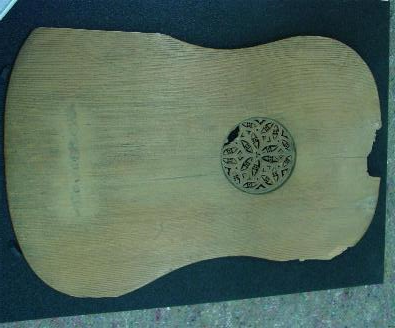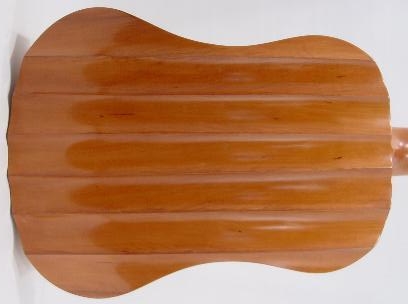The E.7048 Model "Chambure" Vihuela
One of the most exciting additions to the body of extant historical instruments has been that of the vihuela that was rediscovered in the Cité de la Musique when the collection was moved to the new facility from the old Conservatory museum in Paris. Known as the "Chambure" vihuela, it is only the third vihuela to come to light and it is a unique style that is not found in iconography of the 16th century. It is unique, also, because it is unaltered and in, what looks like, completely original condition. The museum has left the instrument open for study and we now have an opportunity to see exactly how this style of vihuela was made, an opportunity that was unthinkable a few years ago.
We have known from 16th century inventories that there were two main styles of vihuelas that were made. One style had a flat back and the other had “ribs.” This was always assumed to have referred to some type of vaulted back but until this instrument was accepted as an authentic vihuela, we were not sure in what style the “ribs” were constructed. This instrument obviously represents one style of a “ribbed” vihuela.
Even more than construction style, this instrument gives us a chance to hear what a 16th century vihuela player may have expected to hear from an instrument. This is an important point, because this instrument has a very different tone than we have come to expect from lutes and vihuelas. The back is very thin with rib thicknesses of 1.00mm - 1.20mm. The ribs are a little thicker at 2.00mm - 2.20mm, and the front is very thick from 3.5mm around the bridge to 2.5mm around the edges. There is also good evidence that the instrument was lightly strung and the resulting tone is very resonant and sweet, but not very loud as many modern instruments are expected to be. The strings on the original instrument are very close together both within each course and between each course, demanding a very light playing style.
For those musicians who want to truly explore historical performance style and technique, I am pleased to offer this instrument as exact a copy as is my ability to make, with original string spacing's.
I will also make the instrument with a modern, conventional string spacing with a wider neck.
I have also reduced the design to the size for instruments to be tuned in "g" with a 59.5cm string length and "a" with a 52cm string length.
Chambure vihuela specifications:
String length: 64cm, tuned to "F"
Neck length: 29cm (113/8")
Body length: 43cm (17")
Body width, lower bouts: 33cm (13")
Body width, upper bouts:27.5cm (10 3/4")
Rib width: 9cm (3.5") at widest point
Materials:
Back and ribs: Pear, Mahogany, or Yew
Front: Italian or Turkish Spruce
Neck and head: Mahogany
Fingerboard: Ebony, with points
Rose: pearwood, by Elena dal Cortivo
Strings: Gut
Pegs: Boxwood, rosewood, or ebony
| Table of string spacings for the Chambure model vihuela Bridge |
||
| Original spacing | Modern spacing* | |
| String to string in each course, center to center | 3.5mm | 4.70mm |
| Space between courses | 7.75mm | 10.0mm |
| Distance from first string to last string | 70.55mm | 78.20mm |
| *These modern spacings are standard Larson spacing. Custom spacing is available. | ||
| Table of string spacings for the Chambure model vihuela Nut |
||
| Original spacing | Modern spacing* | |
| String to string in each course, center to center | 2.20mm | 2.70mm |
| Space between courses | 5.20mm | 5.40mm |
| Distance from first string to last string | 39.2mm | 43.2mm |
| *These modern spacings are standard Larson spacing. Custom spacing is available. | ||





















